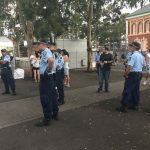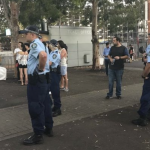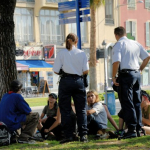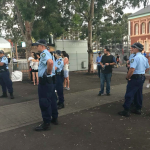UK Takes Steps to Stop the Illegal Strip-Searching of Kids, While the Practise Continues Unabated in NSW
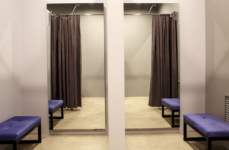
The illegal strip-searching of children by police officers is an issue of great concern both here in Australia as well as overseas, with the degrading, humiliating and ineffective procedure having the potential to leave long-lasting psychological scars on some of the most vulnerable members of our society.
But while there are civil liberties organisations as well as sections of politics calling for a halt to the routine strip-searching of our children – including kids under the age of 10 years and even toddlers. and for the adults who unlawfully exercise it to be brought to account, those calls – like others which seek to stand up against police misconduct – have fallen on deaf ears. And the body that is meant to act as a police watchdog – the Law Enforcement Conduct Commission (or LECC) – has neither the resources or power, nor the inclination, to do anything about it.
To add to this, police commissioners in our state are not only inclined to allow police to keep contravening the requirements of the Law Enforcement (Powers and Responsibilities) Act 2007, which sets out the rules for strip-searching children, they are incensed and even angry with any criticism of officers for routinely breaking the law and harming kids in the process.
To add to the problem even further, New South Wales police officers who are actually found to have repeatedly and illegally strip-searched kids have been able to escape any consequences by claiming ignorance of the law; as if they should not know not to strip and search children with impunity.
And when it comes to Aboriginal children, police officers seem to believe they have the power to search without any proper basis, disproportionately targeting these particularly vulnerable kids who have often already experienced extreme disadvantage and even trauma.
In the United Kingdom, however, citizens have had enough and have been staging public protests against the stripping and searching of children – which many believe can amount to state-sanctioned child sexual assault, and parliaments appear to be taking action.
Similar situations in Australia and the United Kingdom
It is clear that not only are there similarities in the convenient general ignorance of the laws in relation to strip searching of children between Australia and the United Kingdom by law enforcement authorities; but that similar to coloured people in Britain, there is also a disproportionate strip searching of Indigenous children in Australia.
If there is something to be learned from the UK study by Dame Rachel de Souza DBE, the children’s commissioner for England, to benefit Australia, it will come from her analysis of the traumatising strip searching of children in the low thousands.
The recommendations take to task every conceivable governmental and non-governmental organisation accountable for the safety of children and explains in chapter and verse precisely what and why their integral involvement is critical to the wellbeing of our children.
Why Australia should act now and commission an inquiry in relation to strip searching of children per se, is that despite investigating organisations, like the NSW law enforcement conduct commission’s findings on unlawful strip searches; and similar bodies in other states in Australia making findings of unlawful conduct in the management of strip searches in general, not much has changed.
The fact is that older people are generally more resilient than children and have a tendency to better deal with a strip search that a child may do.
The psychological health risks to children who are strip searched:
The Juvenile law centre (JLC)on why strip searches are harmful suggest that:
The experience of a strip search can cause youth to suffer anxiety, depression, loss of concentration, sleep disturbances, difficulty in school, phobic reactions, shame and guilt, some of the symptoms suffered by the heroine of this article, Q.
JLC goes on to say that:
Trauma during adolescence may have a particularly significant effect on the development of the frontal lobe, the area in the brain that is responsible for thoughtful decision-making and measured responses.
Trauma to this area of the brain during a youth’s development can result in lasting consequences into adulthood.
The juvenile law centre is a US based non-profit organisation, whose purpose is juvenile justice and child welfare reform.
NSW juvenile justice
Youth in Frank Baxter and Cobhan juvenile justice centres told the BBC several years ago how strip searches caused them mental health issues.
British psychological society
In relation to the catalyst, that of the young schoolgirl, Q, that prompted the following report by Dame Rachel de Souza, the British psychological society working group of a number of psychologists from across all psychological disciplines was set up.
The psychologists found that not only was Q’s rights breached in relation to the United Nations declaration on the rights of the child but were deeply concerned regarding the traumatising of child Q, compounded by the racial profiling and discrimination she suffered.
State statistics in Australia
Between July 2020 and May 2022 in New South Wales, police strip searched in excess of 100 children and, disproportionately, First Nations children, amongst a total of over 4,400 New South Wales residents, indicating racism and discrimination is alive and well.
Victoria, similarly, shows clear signs of racism and discrimination, with significant numbers of First Nation peoples and children subjected to strip searches.
December 2022 saw the Yoorrrook justice commission told of allegations of racist treatment of First Nations children by Victoria police, accompanied by violence. Similar allegations have been made fairly consistent over the past few years.
As the Royal commission concerning Lawyer X, so aptly laid it out on the table, it appears to the casual observer that Victoria police has many issues to confront, in terms of integrity.
Western Australia has apparently seen a massive increase over the past years, though cannot provide accurate figures as they say they do not keep records of strip searches unless the person is in custody. Sounds a bit strange, if not misleading? It is stated that since 2015 until 2020, there had been an increase of 37% in child strip searches, of which 40% was indigenous children. This therefore also clearly shows that WA is keeping the Australian bandwagon of racism and discrimination rolling on.
Queensland, in the past few years, has seen its corrections officers accused of serious racism of a vile nature, not discounting the accompanying aspect of discrimination. This was alleged by a whistle-blower and includes allegations of innocent indigenous youth being strip searched.
It’s looking like Australia has no decent way of treating all people fairly and equitably.
South Australia appears a contradiction in terms. It appears to have a strong affinity with ensuring the positive interaction with children, yet very little current updates.
Yet, several years ago, the Adelaide youth prison was involved over a 9-month period in strip searching 830 children, some of whom were 10 years old.
Counter to this, SAPOL in 2022 introduced autism training for its members, as the state has about 25,000 adults and children on the autism spectrum.
Northern Territory’s children’s commissioner, Colleen Gwynne, a former commander with Northern Territory police, was found not guilty of abuse of office about a fortnight ago, with the case withdrawn. It will be interesting to see the fallout from recordings played in court of the commissioner’s racist slurs about the acting commissioner.
In relation to searches, Northern Territory defies the odds and restores faith in human nature, not to say, also the criminal justice system.
For intimate procedure search, nice words for a strip search, you can have doctor or dentist of your own choice. Child strip searching appears not to be permitted under the youth justice act (NT) and the child cannot be required to remove clothing is if the police have reasonable grounds for believing the clothing may provide evidence of an offence.
The police have to replace any clothing taken with adequate garments.
Tasmania in June 2022 saw the Tasmanian parliament’s decision to pass a law preventing the routine strip search of children and young people in custody.
The commissioner for children and young people, Leanne McLean, said that the passing of the youth justice amendment (searches in custody) bill 2022 was a very important step in creating a safer environment for our children and young people in custody.
Ms McLean has been fighting for such a result since 2019.
Australian Capital Territory (ACT)
Another seemingly respectful and responsible Australian territory, which although has stop and search powers, does not appear to abuse them.
Children 10 years and above, but under 18 years can be strip searched, but only in the presence of a parent or guardian.
Strip searching must not involve searching a person’s body cavities, removing more garments than reasonably necessary, nor more visual inspection than reasonably necessary.
The UK report
In England and Wales, society had enough of their children being traumatised and took to the streets to march in protest.
Children as young as 8 years of age, traumatised by unwarranted strip searches in exposed locations by police forces in England and Wales, appeared to become the norm for policing of children.
A study by the children’s commissioner, Dame Rachel de Souza DBE, prompted by the strip searching of a 15-year-old coloured Hackney schoolgirl by London’s metropolitan police service, known as the MET, was released today.
The strip search, conducted by two MET police officers at the school after removing the girl from a classroom where she was sitting an exam and whilst experiencing her menstruation, can only be described as an assault.
The girl, code named Q had been suspected of possession of cannabis.
No independent adult was present during the strip search.
Her intimate body parts were exposed and to compound the trauma experienced, the girl was instructed to remove the sanitary pad.
It was put more explicitly by a question in parliament to the British secretary of state last year thus:
“They walked into her place of safety at the request of people who were meant to keep her safe, strip searched her naked while she was on her period and forced her to remove her sanitary towel, spread her legs, part her buttock cheeks and cough, to look for drugs that were never found.”
“They” were police officers, her place of safety was her school and the people who were meant to keep her safe, were her teachers.
The child’s parents were not informed of the strip search and after the young girl’s unfortunate experience, statistics revealed that the London metropolitan police (MET) had strip searched 650 children between the ages of 10 and 17 years, between 2018 and 2020.
Hence the reason, the children’s commissioner called for all statistics in relation to strip searches from all police forces in all of England and Wales.
58% of those children were coloured.
This occurred in 2021, with the national police chief’s council amongst many government authorities promising change to management of the most vulnerable of society, our children.
As this article will reveal, this was simply paying lip service, as nothing had significantly changed at all, with children continually being traumatised, despite an earlier report published in 2022 advocating for change.
Against the advice of the oversight body, the Hackney review goes ahead
What is known as the city and Hackney safeguarding children’s partnership (CHSCP) conducted a local child safeguarding practice review (LCSPR) which involved investigating what occurred to the child Q and suggested it was likely that a factor of the search involved racism.
A LCSPR is a systematic review of serious child safeguarding cases at both a local and national level and is used to investigate causes of abuse or neglect to identify whether there are changes which could be made, in order to eradicate similar occurrences .
The oversight national body, the child safeguarding practice review panel (CSPRP) is an independent government department, which has its own statutory powers and works with schools and other organisations concerned with the safety of children.
Yet surprisingly, this body suggested to the CHSCP that in its opinion, a review did not meet the criteria.
However, the CHSCP decided to initiate the LCSPR with the support of the CHSCP’s independent child safeguarding commissioner(ICSC), Jim Gamble QPM.
The CSPRP was provided for by the children and social work act 2017 and itself, provides statutory guidance for:
- Local authority chief executives
- Directors of child services
- Safeguarding partners
- Teachers and education staff
- Social workers
- Health service professionals
- Adult services
- Police officers
- Voluntary and community sector workers in contact with children and families
So, in relation to the young Hackney schoolgirl who was subjected to unconscionable acts, it concerned statutory guidance to two of the entities above, namely teachers and education staff and police officers.
Whilst going through all of the relevant acts and conventions, such as the United Nations convention on the rights of the child (UNCRC) and the European convention of human rights in chapter and verse, eventually it came down to a simple conclusion; which found that there had been no reasonable justification for the police to strip search Q and that many lawful processes had been ignored by the police officers and school teachers who had called the police in the first place.
The teachers said that they called the police as the child had smelled of cannabis. One may well ponder how the teachers knew what cannabis smelled like.
Result of the local review
The teachers were found to have initially acted in accordance with the panel’s department for education guidance in their initial search of Q, which was not a strip search.
However, they later deferred to the police officers who were about to strip Q, rather than challenge their decision.
The city and Hackney LCSPR found that school staff and police failed in their child safeguarding guidance mandate, resulting in unlawful actions against Q, which were disproportionate and harmful to Q and that her safety and welfare were ignored by such action.
This review also determined that it is unlikely to have occurred if she had not been coloured, qualifying this by adding that the review showed that it is clear that the strip-search of child Q should never have happened.
It appears that the girl has become reclusive and is involved in self-harming requiring psychological therapy.
As a result of what happened to the young, coloured girl Q, it prompted the children’s commissioner, Dame Rachel de Souza’s study, concerning the years 2018 to 2022 and covering children from ages 10 to 17 years (The age of criminal responsibility).
The report though, mentions children as young as 8 years having also been strip searched. This however appears anecdotal at this stage.
The findings are apparently as shocking as those of Dame Casey’s recent final report into the MET, which found that institutionalisation concerning racism, homophobia, misogyny and Islamophobia and ableism existed.
Further mentioned, was that there were issues concerning the protection of children, however, Dame Casey was obviously leaving the specifics to Dame de Sousa’s report.
Despite coloured children making up only 5.9% of the population, making them more possibly 6 times more likely to be stripped and searched during the period, 2018 to mid-2022, 38% of the children were coloured.
A total of 2,847 were strip searched in schools, amusement parks, fast food outlets and police cars and vans.
39 of England and Wales police forces provided statistics of which 27 forces will be referred to the police watchdog, the independent office for police conduct (IOPC), as it was found there were breaches of the statutory code of practice amongst other deeply concerning practices.
This includes the finding that there was no recording of the searches in 45% of cases.
It should be noted that a significant percentage of those being strip searched were handcuffed, as indicated by the central east basic command unit (BCU) of the Metropolitan police service (MPS).
MET apologises to schoolgirl
Scotland Yard, as the MET is sometimes referred to, stated when apologising to Q for the traumatic strip search conducted by two female officers, that it was regrettable and should never have happened.
There are thousands more children who should be apologised to.
The Dame’s Final Report
This report is primarily in relation to strip searches of children, which is specifically searches which expose intimate parts of the child’s body and shows what happened to Q was part of systemic problems regarding methodology in such searches of children.
In short, the girl Q was not an isolated incident and highlighted the deeply concerning aspect that there are very minimal safeguards, no transparency and next to no scrutiny.
Another young autistic girl, code named Olivia, after her experience attempted to commit suicide.
Whilst the independent office for Police conduct (IOPC) is yet to hand down results from its investigation of the child Q, it is also investigating a number of other cases of potentially inappropriate searches of children by the MET. However, this is not simply a MET issue, but one affecting practically the whole of policing in England and Wales.
- 2020 – 2022 police in England and Wales searched 115,601 children
- 2021 – 2022 police in England and Wales searched 94,975 children
- 95% of those searched were boys
- 38% were coloured children
- 52% occurred without an appropriate adult present
- 37% were strip searched at a police station, with 12% at home and 45% searched at an unrecorded location, but included fast food outlets, amusement arcades and police cars
- 51% resulted in no further action
- 24% were aged between 10 and 15 years (no mention of the figures provided by police mentioned 8-year-olds, as outlined earlier
This indicates that the minority of child searches are strip searches, however still number in thousands of children, albeit low thousands and result in a significant numbers of cases in both physical and psychological harm to the child.
Demographic variables
Of the children strip searched 20 were aged from 10 years to 12 years, 667 from 13 years to 15 years and 2,164 from 16 years to 17 years. Of those 133 were girls.
The statutory code of practice is called PACE Code A, which comes under the police and criminal evidence act 1984 (PACE), which regulates police powers to stop and search people.
PACE of course stands for police and criminal evidence.
Conclusion and recommendations:
The children’s commissioner’s request to all English and Welsh police forces for data which the office of the children’s commissioner analysed for the preparation of this report, showed conclusively that the problems associated with child strip searches were not solely the domain of the MET.
The commissioner identified 27 other police forces where there are concerns in relation to the safeguarding of children, which includes breaches of the statutory code of practice and as such has made the following recommendations:
- The Home Office should conduct a comprehensive review of the legislative and policy framework for searches involving children in custody and stop and search powers. The review, which should include public consultation, should aim to ensure that children are only ever strip searched in exceptional circumstances where it is necessary to protect them or others from significant harm and that these searches should occur in a safe and appropriate environment in accordance with strict and transparent procedures that are subject to scrutiny.
- The Home Office should make specific changes to the Police and Criminal Evidence (PACE) Codes A and C in order to strengthen the statutory safeguards for children strip searched by police. The Commissioner recommends that Codes be strengthened as follows:
- Strip searches of children in custody or under stop and search should require a higher threshold that recognises the potential traumatic impact on children;
- An appropriate adult must always be present for strip searches of children in custody and under stop and search, except in the most exceptional situations where there is serious risk to the child’s life or welfare. Urgency should be removed as an exception to this requirement and constant supervision should be recommended;
- Strip searches under stop and search may only be conducted at a nearby police station, medical premises or home address. Schools should be specifically excluded as an appropriate location for a strip search;
- Strip searches should be authorised by an inspector, or ratified by a custody inspector in custody;
- Parents or guardians of children should be informed in advance of strip or intimate searches of children in custody and under stop and search. Where a child refuses to provide information under stop and search, this should be recorded;
- A safeguarding referral should be made whenever a strip or intimate search of a child is conducted. Where a child refuses to provide information under stop and search, this should be recorded;
- Strip searches in custody or stop and search should not be conducted in front of officers of another sex to the child;
- The potentially traumatic effect of strip searches on children and a police officer’s duty to safeguard children should be emphasised;
- Reduce ambiguity between the safeguards for strip searches conducted in custody and stop and search; and
- Resolve the contradiction between PACE Codes and case law regarding the amount of physical contact permitted in strip searches and intimate searches.
- The College of Policing should amend Authorised Professional Practice for strip searches and police interactions with children to emphasise the duty of police to safeguard children during searches.
Improve data to drive transparency and accountability
- The Home Office should require police forces to report annually on the searching of children under stop and search. This should distinguish between more thorough searches and strip searches, and include ethnicity information on the child, whether an Appropriate Adult was present, the specific location of the strip search, and whether a safeguarding referral was made.
- His Majesty’s Inspectorate of Constabulary and Fire & Rescue Services (HMICFRS) should embed and improve changes to scrutinise strip searches under stop and search in the framework for PEEL inspections of police forces.
- Police forces should report annually on the number and circumstances of strip searches involving children to Police and Crime Commissioners and independent community oversight mechanisms, such as independent advisory groups and stop and search scrutiny panels
Improve practice and compliance in all police forces
- Police forces should commit to reviewing all concerning strip search cases identified by the Child Commissioners office (CCo) and refer these to the Independent Office for Police Conduct (IOPC).
- Police forces should commit to training for frontline officers, who may conduct stop and searches in the course of their regular duties, on safeguarding children and trauma-informed practice.
- Police forces, as public bodies with obligations under the Equality Act 2010 and Human Rights Act 1998, should commit to working with the Equalities and Human Rights Commission (EHRC) as required after publication of this report in order to deliver necessary reforms.
- His Majesty’s Inspectorate of Constabulary and Fire & Rescue Services (HMICFRS) should conduct a thematic inspection of strip searches of children under stop and search.
- His Majesty’s Inspectorate of Constabulary and Fire & Rescue Services (HMICFRS) and the office for standards in education, children’s services and skills (Ofsted) should consider a Joint Targeted Area Inspection (JTAI) approach to safeguarding outcomes for children interacting with police.
Broader change in police interaction with children and the adoption of safeguarding first policing approach
- The National Police Chief’s Council (NPCC) should publish an action plan on reforming stop and search practices, including strip searches of children.
- The National Police Chief’s Council (NPCC) should update their child-first approach to policing and publish a comprehensive strategy for ensuring that every police force takes a safeguarding first approach to policing children. Every force should have a named senior officer whose responsibility is to implement the strategy.
- Police forces should share strategic information on strip searching of children with local safeguarding partnerships and serious violence duty-holders to inform their priorities and work to assess and understand local needs;
- The Crown Prosecution Service and the Home Office should consult on adding a safeguarding referral outcome to the Crime Outcomes Framework to encourage police officers to refer vulnerable children to children’s social care; and
- As recommended in the CCo’s Independent Family Review, the Department for Education, the Department of Health and Social Care, the Home Office and the Ministry of Justice should consider how the functions of Local Safeguarding Partnerships, Health and Wellbeing Boards, Adult Safeguarding Boards, and Community Safety Partnerships could be rationalised, and the bodies merged with consolidated duties, powers, funding, and accountability. Schools should have a formal role in this rationalised partnership, which should have operational as well as strategic functions.
There are more than 12 million children in England and Wales and the above recommendations if implemented, will go a long way to ensuring the rights of each child is foremost in the minds of those charged with keeping them safe.
Remember, 2021 to 2022 saw police forces conduct 94,975 stop and searches of children.

